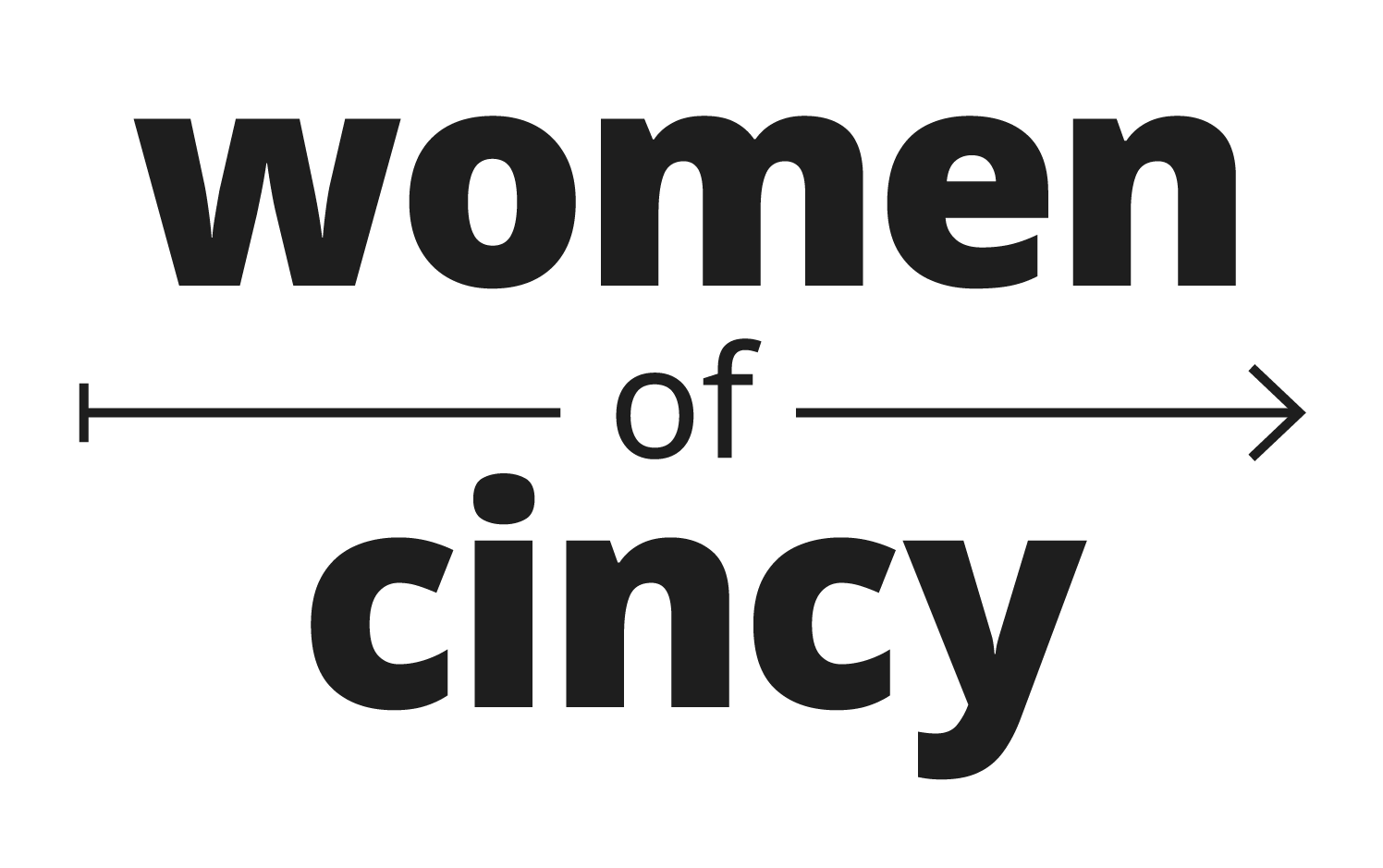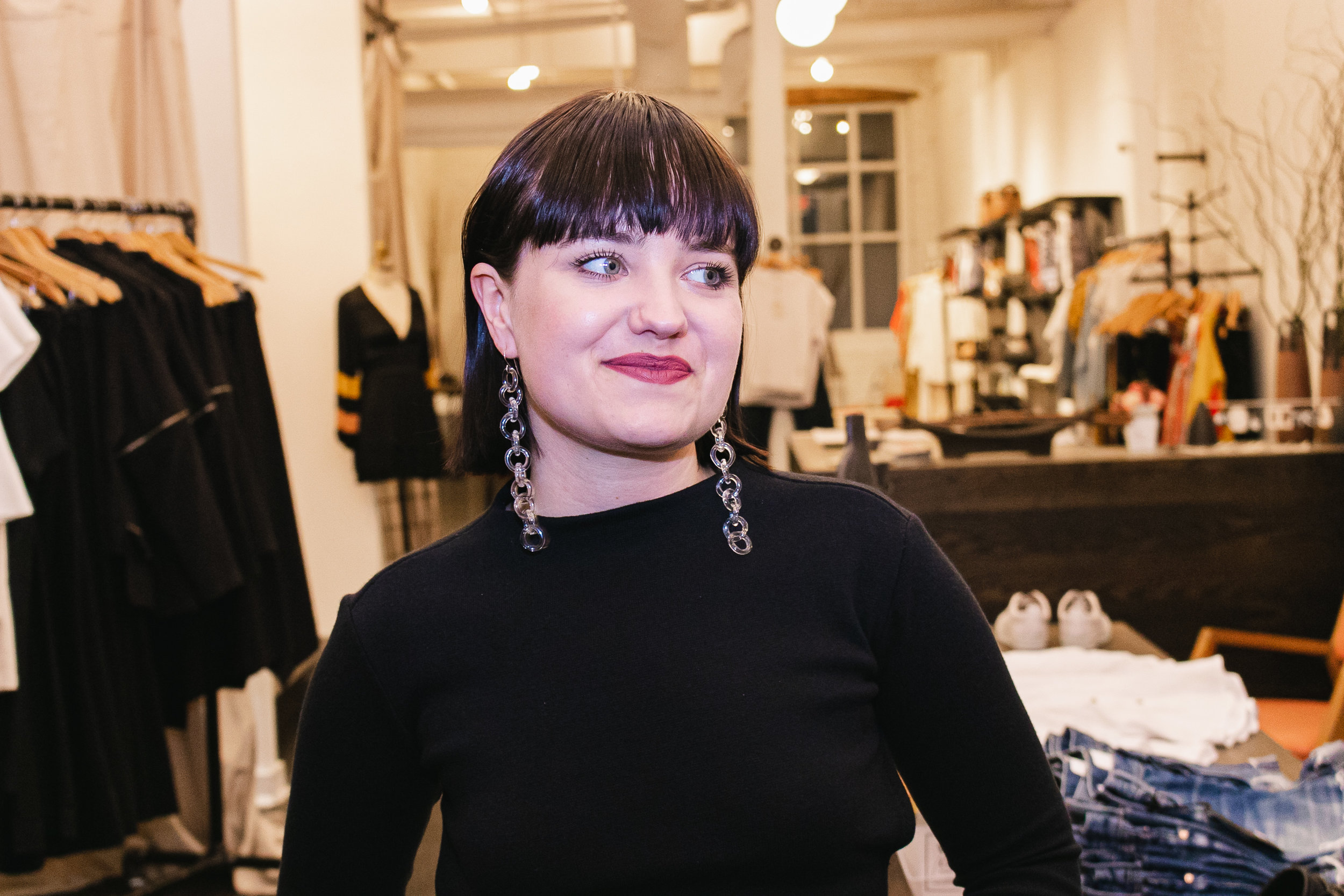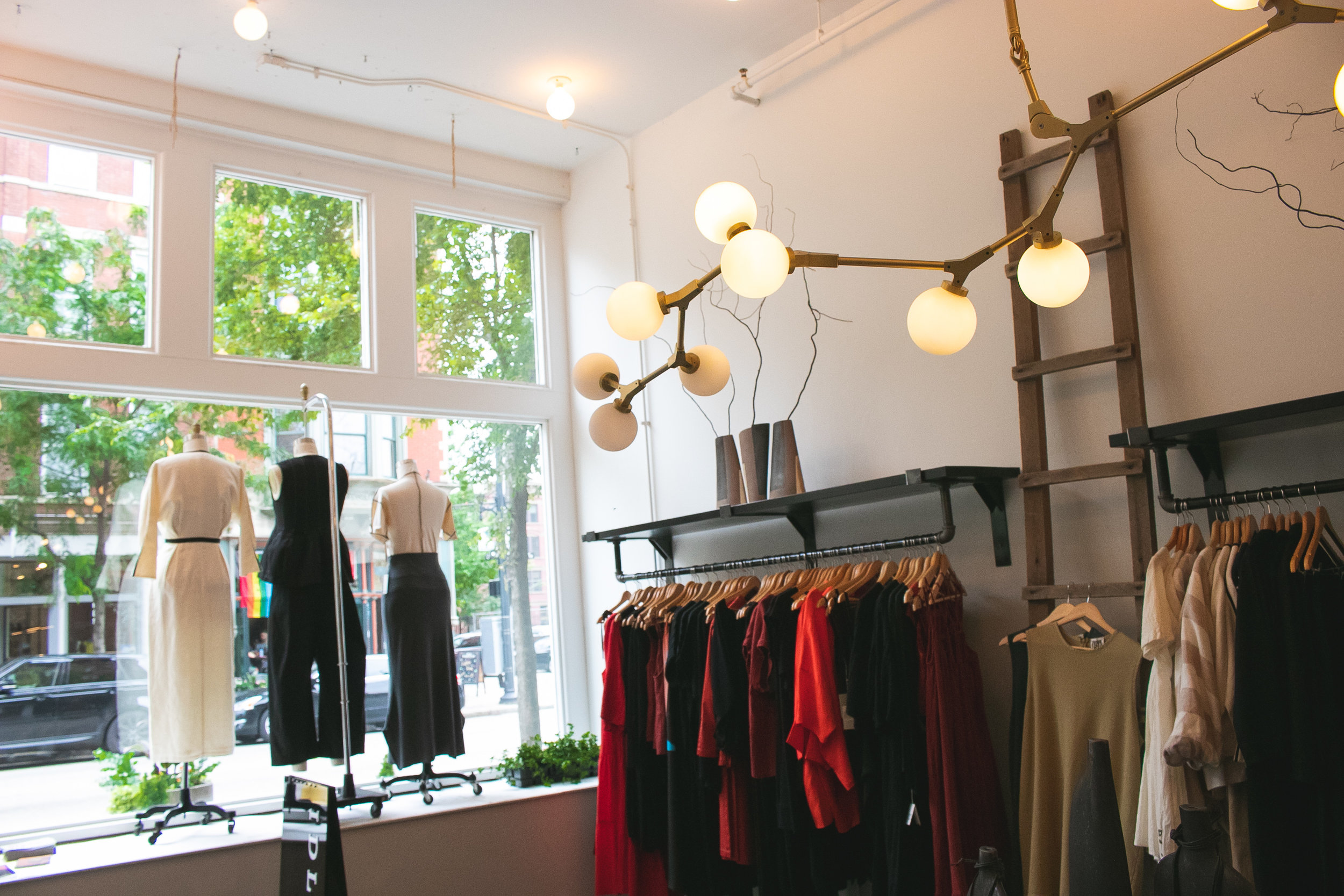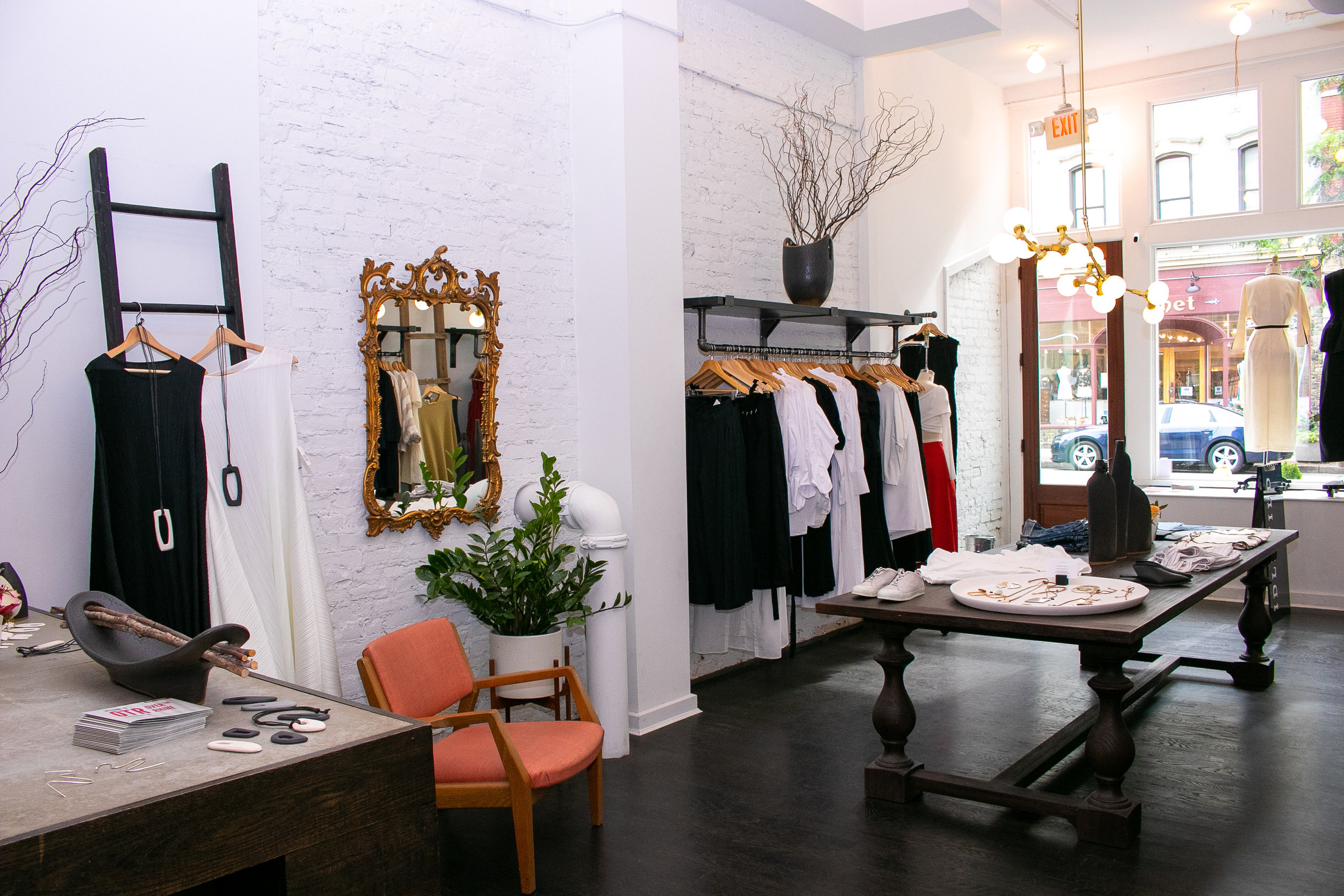From Runway Projects to ‘Project Runway’: A Conversation with Tessa Clark
For those of us born with a fascination with fashion, the shirts on our backs are about more than function. What we choose to wear can be a source of confidence, a way to tell someone passing by a little bit about who we are – even what we stand for. And on a rainy summer evening, I scurried down Vine Street with my deteriorating cat-ear umbrella to meet Cincinnati’s rising style icon and nationally recognized designer, Tessa Clark.
Clark is a DAAP grad, hot off the set of season 17 of “Project Runway.” Since she’s been back, Cincy has been buzzing about her appearance on the show, and all eyes have been on her luxury womenswear line, Grind and Glaze.
“I try to design timeless pieces that will last a lifetime in your wardrobe. That’s how I personally dress, buy, and shop,” she said.
We met Tessa at Idlewild Woman – a curated shop managed by Tessa and owned by her mother, Julie, and her cousin, Jessica. The aesthetic is Parisian boutique meets industrial chic. Iron shelves and racks host carefully selected pieces from sustainable brands – including Grind and Glaze. Dazzling chandeliers drip with tiny crystals. White brick walls and large mirrors make the space feel airy and welcoming.
But what stood out to me most was Clark’s warm, genuine personality and the kind smile that rarely leaves her face. She represents Idlewild with pride and confidence.
“I really wanted to do ‘Project Runway’ to bring more recognition to my brand, to put Cincinnati on the map for fashion – not that it wasn’t, but trying to drive it more,” she told us.
Tessa showed us to a quiet seating area in the back of Idlewild, and we chatted about going from life in the country to “Project Runway” and all the defining moments in between.
Interview by Brittany Barker. Photography by Chelsie Walter.
Where did you spend your childhood years?
I’m from Greenville, Ohio, and I grew up in a barn house next to a historic mill. My parents bought the mill in the late ’70s and took it over. They renovated the barn next to the mill and turned it into their home; my mom’s ceramics studio is in the bottom of the barn. They still live there. That’s where I grew up, hence the name “grind” of grain and “glaze” of ceramics – so Grind and Glaze. It was a really cool upbringing – it was really different living in a barn house with my mom as an artist and my dad as a miller.
Did living in the country help you foster your creativity?
Yes: I had to entertain myself often. I lived in a barn in the middle of the woods next to a mill, so I was always playing outside, and I was definitely a tomboy – running through the woods, catching bullfrogs. I had to play make-believe a lot and it was very lyrical and whimsical.
It sounds like your mom was a big part of your inspiration in fashion. What’s her style like?
Yes, she dresses so well for her body. I always remember her dressing really well and caring about how she carries herself. Of course, in the studio she wears whatever – jeans and an apron – but even when she’s doing the simplest things, she looks chic. Even if it’s a long tunic, jeans, and a pair of cute shoes. I don’t know how she does it. But she’s always loved fabric. We would go to little fabric stores growing up and she’d buy fabric to make curtains – so fashion has always been part of my life in that sense.
You have a very distinct style. Has it always been this way, or has it evolved over the years?
I would say it’s evolved over the years. My mom has a big influence on that, too, I think. I tend to buy a lot of staple pieces and don’t wear a lot of color, but when I do, it’s a random color. In general, my life is so focused on quality textiles, sustainable and ethically made clothing, so I try to buy and support those designers. I would say my personal style is very similar to Grind and Glaze, but it’s casual. I wear a lot of jeans. I think it’s casual, and then other people are like, “Why are you so dressed up?” I’m not.
Clothes make me feel good, which is why I think people love fashion. I wear my own designs so much less than I wear other people’s designs. People always ask me, “Did you design that?” No, I didn’t. I don’t have time to design everything I wear.
Did you have any instructors in DAAP who had a big impact on your career?
Margie Voelker-Ferrier is a good friend and mentor. And she really encouraged me throughout school to pursue my upbringing as my inspiration. It was really Margie that led me to focusing on what is now Grind and Glaze, so that’s special. And Margie is just so inspiring in general to me. I would also say Hanna [Hall], who is no longer with us, but I was her teaching assistant. Just teaching alongside her, I learned so much.
[Editor’s note: Margie Voelker-Ferrier passed away after this interview was conducted. Margie was a beloved instructor, mentor, and mother.]
Are there any other women in Cincinnati that’ve made an impact on you?
Oh my gosh, yeah. So many, I have to think about this. Jessie Cundiff is an amazing stylist and she’s based here in Cincinnati. She does a lot of set styling for big brands. She’s worked for Tom Ford, and in general she is really inspiring. Also, Rosie Kovacs, who’s the founder of Sew Valley and Brush Factory. My studio is located at Sew Valley, and Grind and Glaze wouldn’t exist like it does now in Cincinnati – having everything produced here – without Sew Valley.
Did you always know you wanted to design for yourself? How did Grind and Glaze come about?
My senior thesis was titled “Grind and Glaze,” and it had such good feedback from professors and friends. People asked if I was going to start my own business. And in the fall of 2016, I started. I bought some fabric and I started hiring home sewers to produce my things in Greenville. I was back living at home after school. I started doing little popups and selling at a local boutique in Greenville, and just selling off Instagram and stuff. Then I knew I shouldn’t just hire home sewers; I had to find production. And the closest production at the time was Chicago or Cleveland or New York. I didn’t have many resources, and when I moved to Cincy and started working here, I needed to take a year to sort of figure out what I wanted to do. Then at the end of 2017, Sew Valley – a nonprofit manufacturing facility – was founded, and I was the first member. I immediately started working on my first collection to have produced. It took a year for me and Sew Valley to get up and running. And I introduced my first collection on December 27, 2018. It was late to launch because I was filming for “Project Runway” that fall.
How did your family acquire Idlewild Woman?
I worked here for a year, and they said they were going to close, and my family said we were interested in buying. They told us what they would want, and it was a steal, so we took it. This space is amazing. They already had great brands; they had the website; they had everything. My cousin – who bought the store with my mom – and myself, we’re all makers, and we already dreamed about owning a store together. Once my cousin moved to Cincinnati and got her roots situated here, it seemed like the perfect opportunity. Now we all sell our products here and stock small designers and lots of sustainably and ethically made clothing. And we get to go on buying trips to New York together, which is my favorite thing. We all merchandise the store, and it’s a great family business. We’ve doubled sales and it’s been a great little endeavor. “Little” [laughs] – it’s my life.
How did “Project Runway” come about for you? What was that process like?
I received an email that a casting agency was looking to cast from Cincinnati, and I replied. I asked about the process and I realized that the application was an insane length, and I didn’t have the time. A week later I sent an email saying “I’m interested in applying,” and they invited me to Chicago for a casting call. A month later I had to go to L.A. to finish interviewing, and a month later I was cast to be on the show.
I watched “Project Runway” since the beginning, regularly through junior high and high school, but not as much since I’ve lived on my own– because I don’t own a T.V., like many millennials. But it’s something that I’ve kept up with. It was always something my friends and I always joked about, like, “I could totally do ‘Project Runway’ because DAAP trained us so well to work under pressure and we’re here 24/7.” It just sort of felt meant to be when I received the email and they ended up casting me. I’m actually the third DAAP grad to be on “Project Runway.”
What did it feel like to be on the show?
It was surreal. It felt like a weird sewing camp. You make all these friends and you’re sewing and it’s fun, but then we’d look up and see “Project Runway” projected on the wall. We’d be like, “Holy shit, we’re being filmed.” Or on the runway, it would be so surreal sitting across from Nina Garcia of Elle Magazine. I made amazing friendships and heard great feedback, made great connections, and had the most fun I’ve ever had. It was great. And the online bullying is real.
How do you handle that part?
The biggest thing for me is: Why would I take criticism from someone I would never go to for advice? I’ve never been a reality T.V. viewer other than “Project Runway,” so I can’t relate. In general, it’s been very positive. A lot of people come into the store just to meet me; it’s definitely brought in more people. For every one person who’s bullying online, there’s a thousand nice people.
What are some of the best things that have happened thanks to the show?
I’ve received so many messages from mothers and people who have told me that I’ve inspired them to go into fashion. Or their daughters or sons sketch me or one of my designs from the show. I think that’s been really great – just having little kids coming up to me and fan-girling. It’s surreal, but people recognize me on the street – especially here in Cincinnati because it’s a smaller city, but it’s happened a few times in New York, too. One time was at the MET and at the fashion exhibit. That’s been fun.
I save every piece of my scraps to use for something else.
When people come to you for advice about fashion, what do you tell them?
I usually ask them to be specific about what they want to know. I ask if they want to create a one-time collection, or do they actually want to produce clothes or found a brand and start a business? There are so many ways you can be a designer. You can work for someone else – just make clothes, or start a brand and produce stock. People always ask me how I started my brand, and I’m very upfront that I took out a small business loan and yes, my mom had to co-sign it because I have zero assets or collateral. And it’s a line of credit that’s against me and my mom, so I have a $15,000 small loan, and I’ve used all of it and have been paying it off, reusing it. I do not pay myself; I do not pay my interns; the interns have to have school credit. I pay the bare minimum for rent. I talk about these things in detail because it’s such a secret in the industry and I hate that.
It takes a lot of money to start your own brand or business, and I’ve been able to do it so frugally because I work a 40- to 50-hour work week at Idlewild and then in my spare time I devote it to that. And I’m very small batch. Depending on the style, I make less than 30 units per style. I save every piece of my scraps to use for something else. It’s a struggle, for sure, to keep it going, but I think eventually I’ll get a return on my investment and be able to pay off the line of credit and be able to fund it myself. That’s what I’m working toward.
Who are you designing for when you’re making a piece for Grind and Glaze?
It’s hard to put her into one specific thing. I had an interesting situation because I manage a store that sells a lot of different designers, but Grind and Glaze is one of them, and I see all the time what women want. Unless someone knows me, they don’t know Grind and Glaze is my brand. I typically don’t tell them until after they bought something, because I want to hear what they think. And so, I get a lot of insight on how things fit, color ways, and fabrics. And it’s proven the woman I design for is definitely ageless. She’s timeless; she cares about quality textiles; she is a feminist; she appreciates art and design. Other than that, a lot of young people come in and tell me that they’ve saved up just to buy something Grind and Glaze. So, for me, there’s not really a certain income that buys my clothes.
How do you select the textiles you use for Grind and Glaze?
I do buy a lot of deadstock fabrics, and that means that it’s factory-seconds or leftovers from previous designers. It’s usually the last of its kind and I think that’s sustainable. A lot of times with large textile companies I can’t meet their minimums of 500 yards.
I scored my Grind and Glaze Turbine Bodysuit about six months ago, and I wear it all the time! Can you tell me a little bit about the fabric selection and the production process?
Your bodysuit is 100% Oeko-Tex cotton, and it meets 100 different standards in the industry for dyes and environmentally friendly things.
For my fall collection, some of my textiles are going to be handwoven here in Cincinnati. Some are deadstock; some are factory seconds; some are new textiles. But I do keep all of my scraps, and I’m working right now on utilizing the smaller scraps that can’t be made into a new garment for filling for a puff coat. Then for the scraps that can be made into a new garment, I usually design something around those.
When you get moments of rest and relaxation, what do you like to do?
It’s really bad; I work a lot from bed. This is why I’m single. Because I don’t have a social life and I don’t go out. I love eating. I spend way too much money on supporting local restaurants: Please, Salazar, Sotto. I manage and design for Grind and Glaze in my downtime, so I go home and go to bed, but will send emails from bed. I also work at coffee shops in the morning. I’m still trying to figure out a work/life balance. Right now, in my downtime I’m planning my first fashion show fundraiser.
I’m also going to be part of a fundraiser based in Louisville on October 12, with other “Project Runway” designers from my season. Frankie [Lewis], who was out the second episode, is doing a fundraiser for a nonprofit that she’s passionate about.
[Editor's Note: Frankie Lewis' fashion showcase, Resurrections, features five designers, including Tessa. Proceeds benefit the Cabbage Patch Settlement House, a nonprofit that aids at-risk youth and families.]
Out of all the amazing women in your life, who inspires you most?
My mom, Julie Clark. She’s just so inspiring in every sense. Her personal style, her boss woman tendencies – I totally get mine from her. She’s a self-taught ceramicist, and she and I have collaborated by making porcelain earrings together in 2015. She sells them here and at a couple of other stores. She’s dedicated her life to making pottery and keeping the mill open to the public. She says she invested in Idlewild for me, so I will hopefully buy her out one day, and I’m so grateful for her.
Do you know an awesome woman of Cincy? Nominate her here! New features launch every Monday.





